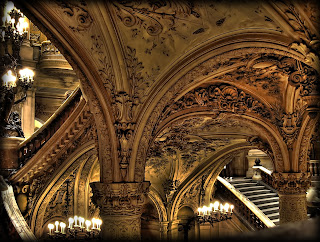Atop the Palais Garnier at Sunrise
Oh, what it must have been like to be a fly on the wall in nineteenth-century Paris. The height of opera, the height of the Ecole des Beaux Arts, the arrival of cuisine and the stylings of a new world order. Things for the bourgeois were pretty damn good then. Literary colossuses such as Hugo, Flaubert, Dumas, Zola and others patterned themselves saviors of a wicked age, true, but what a wicked age it was...
This is perhaps the masterstroke of all Beaux-Arts architectural accomplishments: the Palais Garnier. Built by Charles Garnier in 1875 and fashioned to be Neo-Baroque in style and appearance, what the Eiffel Tower is to steel structures the Palais Garnier is to lavishness altogether.
Just look at it. The gold lighting. The coupled pilasters and the exquisite acumen for detail. The marble staircase. Thousands of chandeliers and candelabras. It is a feat we could not accomplish today even with the money we spend on our buildings. It is a code-defying declaration of national pride and unlike modern spaces - which trumpet simplicity for simplicity's sake - the simplicity here is in the arrangement and promenade. Grand foyer, grand staircase, regal corridors, box seating, lights, camera, action!
The Grand Staircase
A little history: the Palais Garnier is a building of exceptional opulence. It seats an audience of about 2,200 under a central chandelier which weighs more than six tons, and has a huge stage with room to accommodate as many as 450 artists. The style is monumental and considered typically Beaux-Arts or Neo-Baroque, with use of axial symmetry in plan, and its exterior ornamentation.
The Facade at Night
The Palais is decorated opulently with elaborate multicolored marble friezes, columns, and lavish statuary, many of which portray deities of Greek mythology. Between the columns of the theatre's front façade, there are bronze busts of many of the great composers, Mozart, Rossini, Daniel Auber, Beethoven, Meyerbeer, Fromental Halévy, Spontini, and Philippe Quinault. The interior consists of interweaving corridors, stairwells, alcoves and landings allowing the movement of large numbers of people and space for socializing during intermission. Rich with velvet, gold leaf, and cherubim and nymphs, the interior is characteristic of Baroque sumptuousness.
Chandeliers Reflecting off the Foyer Floors
The Beginnings of Organic Architecture
One can notice, if they look closely, the inspiration of other famous buildings such as the Guarantee Building in Buffalo, New York by Louis Sullivan. There is a depth in organic/floral detailing here that implies a growing away from classical roots to a more modern world. And yet, this is a building that retains aspects of both schools of thought. It is not simple, yet is simple in design. And its ornamentation, while sumptuous, seems appropriate for its day in age. The Palais Garnier contradicts, inspires, emboldens and declares to all who experience it. It is simply a force of work.





No comments:
Post a Comment